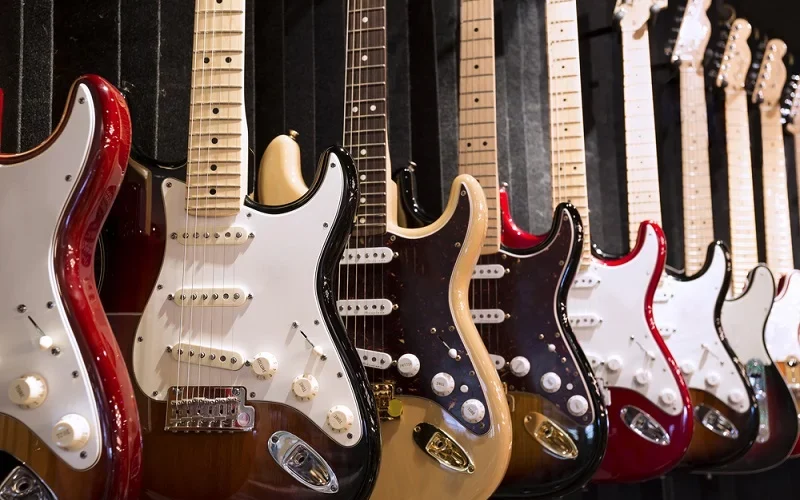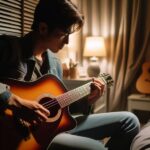If you’re looking to buy a guitar, you’ve likely noticed that all fretboards are not created equal. The aesthetic differences are stark but far from the only difference between various tonewood fretboards.
Though arguably minor, the tonewood used to manufacture the fretboard of a guitar makes a difference to the instrument’s tone and playability. Three types of tonewood make up the vast majority of guitar fretboards: rosewood, maple, and ebony.
The following is all you’ll need to know about guitar fretboards so you can make an informed choice as to which is likely best for you and your playing style.
Key Takeaway:
- Rosewood offers a warm, rich sound, while maple produces bright, snappy tones and ebony delivers excellent sustain and brightness.
- The sustainability of these woods is a growing concern, with several species facing conservation challenges.
- Alternative fretboard materials like Richlite are becoming more common as substitutes for endangered tonewoods.
What is a Fretboard?
Also referred to as a fingerboard, the fretboard is the flat plank of tonewood that lays parallel to and flush against the guitar’s neck. In the part of the guitar where notes and chords are fingered, the fretboard is divided into frets, each delineated with a thin metal bar.
It’s important to understand that, more often than not, the neck of the guitar and its fretboard are two entirely different components.
Does Fretboard Material Affect Tone?
Many factors contribute to a guitar’s tone, some far more than others. The pickups a guitar employs are likely the most significant factor in the tone of any electric guitar; on an acoustic, the primary factor is the shape and size of the instrument’s body.
Many argue, and I concur, that when it comes to tone, a guitar’s fretboard is sort of like the cherry on an ice-cream sundae; it adds a little something to the overall tone, but if you remove it (or rather, swap it out) and you’ve still got a delicious treat that tastes pretty much the same.
Fretboard Types
Theoretically, one could manufacture a guitar fretboard from just about any wood. In practice, some woods perform significantly better than others due to their density, porousness, and affordability.
As such, three guitar fretboard woods are responsible for the vast majority of guitar fingerboards: rosewood, maple, and ebony. As fretboards, these woods produce excellent sound and are easy to work with and play.
1. Rosewood Fretboards
Far and away the most popular of the three top tonewoods, rosewood fretboards are seemingly ubiquitous. If you’ve picked up a guitar, odds are you’ve played on a rosewood board.
Shipped from India, rosewood is a versatile, dense wood that’s inexpensive and relatively easy to work with. Guitar manufacturers can use rosewood to mitigate production costs, lowering guitar prices.
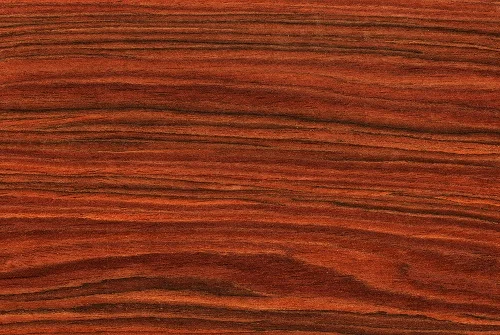
Because it’s relatively inexpensive and readily accessible, one might wonder if a rosewood fretboard sounds as good as the alternatives.
This is a fair question; fortunately, the answer is a resounding “yes.” Rosewood offers excellent tone and playability, so guitar manufacturers as popular as Fender, Ibanez, and Gibson use them widely.
Rosewood Fretboard Types
There are two distinct types of rosewood fingerboards, Indian and Brazilian. Indian rosewood, a dark-coffee colored tonewood, has an even grain and is far easier to procure than Brazilian rosewood. Because it is easier to come by, Indian rosewood is what most rosewood fingerboards are made of these days.
The same coffee color as Indian rosewood, Brazilian rosewood is by far the rarer of the two. Mainly, this is due to the CITES treaty, which banned the export of Brazilian rosewood.
Now a rarity, Brazilian rosewood fingerboards were once very popular. Vintage guitars, already pricey, are often more so because they boast Brazilian rosewood fingerboards.
Though it isn’t technically a form of rosewood, Bolivian rosewood, also called Pau Ferro or Santos rosewood, is another popular guitar fretboard wood. More naturally oily than true rosewood, fingerboards made of Bolivian rosewood offer a tone some describe as between that produced by a rosewood or an ebony fingerboard.
Aesthetics
Two distinguishing characteristics can help you identify a rosewood fretboard: its color and texture. A reddish-brown not quite as dark as a cup of black coffee, rosewood fingerboards are lighter than ebony fretboards and darker than maple.
The texture of the rosewood fingerboard is another good identifying characteristic. If you look closely, you’ll notice slight ridges in the loose grain of the wood. Because this natural effect is so visually appealing, it is unusual to see a rosewood fingerboard with a finish other than a glossy transparent.
Rosewood Tone
Many guitarists attribute rosewood’s tonality to the natural oils present in this tonewood. They argue that the oil contributes to a warmer tone by absorbing overtones or those pitches deviating slightly from true.
Whether this is actually the case, or just speculation on the part of some guitarists, is unclear. Naturally, the best way to experience the tone of any guitar is to pick it up and have a go at it.
Also Read: How To Clean Rosewood Fretboard
2. Maple Fretboards
The maple neck is the most easily identifiable of the fretboard woods because of its color. Unlike the dark rosewood or even darker ebony wood fretboard, maple boards are a light cream color.
A sort of photographic negative of a rosewood or ebony board, the light color of the maple fretboard is most often set off by black fret-markers.

Maple Tone
Harvested in North America and Canada, maple is a dense wood that facilitates high-end tone brightness. Compared to rosewood and ebony, most guitarists agree maple fretboards provide the brightest tone. Maple fretboards also produce warm, tight lows, making them exceptionally tonally versatile and appropriate for nearly any genre of music.
Maple Aesthetics
Maple necks are light-cream colored, with visible grainlines and pores. Because of the color and porousness of the tonewood, maple fretboards show wear in a way the darker woods don’t.
The visible wear that will eventually appear on any maple fingerboard doesn’t affect its playing, and many guitarists (myself included) find this characteristic part of a maple neck’s visual appeal.
A sort of “fingerprint” of a guitarist’s favored positions, it could be said that a guitarist becomes quite literally imprinted upon a maple neck. I’m looking over at my Telecaster as I type and feeling a mix of pride and connection.
Some guitarists prefer a neater aesthetic for their fingerboards, and these folks should factor in a maple board’s inevitable wear before buying a guitar with one.
Maple fingerboards come with different finishes, and the type of finish used can affect playability. Matte finish, satin finish, gloss, lacquer, and oil can all be used to treat a maple fretboard. A matte finish feels almost like playing bare wood, whereas oil facilitates a much greater slide.
The most commonly used finish for maple fingerboards is lacquer, a shiny protective coating that’s sprayed on.
3. Ebony Fretboards
The last of the top three tonewoods for guitar fretboards is ebony wood. Ebony boards are quickly gaining ground on their rosewood and maple counterparts.
This is due, in part, to the limitations the CITES treaty placed on Brazilian rosewood, but primarily because more guitarists are discovering its quality as a tonewood.

Macassar Ebony Vs African Ebony
There are mainly two types of ebony woods used on guitar fretboards: Macassar ebony (Diospyros celebica) and Gaboon or African ebony (Diospyros crassiflora). Macassar ebony comes from Southeast Asia (mainly from Indonesia) and African ebony is sourced from various African countries.
Ebony trees grow naturally in varying shades of black, the wood chosen for the vast majority of ebony fingerboards is solid jet-black.
Unfortunately, ebony wood has been overharvested and is considered endangered as per CITES Appendices and IUCN Red List. Worse, a good portion of the wood harvested had been wasted up until recently due to its less-than-uniform color. Thanks to Taylor Guitars, this “waste” ebony is now being incorporated into beautiful-looking and sounding guitars.
Ebony Aesthetics
While both are primarily jet-black, Asian differs from African ebony wood in that it can have a zebra-like appearance with black and brown stripes running through it. Asian Macassar ebony contains a uniform grain pattern whereas African ebony has a more variable grain pattern.
Some Asian ebony fingerboards are mistaken for rosewood boards, as they are both dark, usually with light-colored fret markers.
Ebony Tone
Though more like rosewood in appearance, the ebony fretboard has more in common tonally with maple boards. Maple and ebony are both dense hardwoods that produce bright highs perfect for the lead guitarist. All said the ebony fingerboard produces a snappy, pleasing high-end while delivering tight mids and lows.
Playability
Ebony tonewood offers smooth playability primarily due to its natural oils. Ebony boards are so naturally oily that no finish is needed when manufacturing them. When playing on an ebony fretboard, you’re unlikely to feel any of the “stickiness” that often comes with certain standard fretboard coatings.
Miniscule but noticeable grooves in the natural wood provide a great “bite” when you finger a note without compromising the speed or smoothness of the transition. The ebony wood’s natural oils provide the perfect counterbalance, making the ebony board a versatile tool.
It has to be mentioned that a very small percentage of guitarists have reported allergic reactions after switching to playing on an ebony fretboard. While such reports are extremely rare, you should probably play on an ebony board a few times, at least, before deciding to purchase one.
Except for Brazilian fingerboards, Ebony boards are the most expensive of the top three types, and by a fair margin. For this reason, guitar manufacturers have begun exploring synthetic replacements for ebony, including Richlite.
Honorable Mention: Indian Laurel Wood
One more guitar fretboard wood deserves mention: the Indian Laurel wood fingerboard. Ranging in color from dark to a lighter brown, Indian Laurel fingerboards are known for delivering balanced output throughout the length of the board.
A straight-grained, moderately hard tonewood, Indian Laurel delivers rich tones with bright highs and more than satisfying lows. Indian Laurel boards are fast gaining popularity among guitarists and manufacturers alike due to their smooth playing feel and brilliant response.
Indian Laurel has similar aesthetics and playability to rosewood and is often used as an alternative. Fender, among other companies, now uses Indian Laurel fretboards instead of rosewood on some of their guitars.
While many argue that Indian Laurel is superior to rosewood, it seems just as many argue the opposite. Most acknowledge, though, that the difference between the two is one of the degrees and that each is a valuable and rich tonewood.
Jatoba Fretboard
Jatoba, also known as Brazilian cherry, is now becoming a popular hardwood and rosewood alternative used in constructing guitar fretboards. Jatoba is prized for its rich, dark color, ranging from reddish-brown to almost black.

In addition, this wood imparts a warm tone to the guitar with plenty of sharp mid-range frequencies. Jatoba is also a hard and dense wood, making it ideal for use on the fretboard where it needs to withstand a lot of wear and tear.
Another good thing about Jatoba wood is that it is almost similar to rosewood in terms of looks and sound but is less pricey. Unfortunately, in some cases, the subtle differences between Jatoba and rosewood make it challenging to find out which one is in use.
Jatoba fretboards can be found on guitars from a variety of brands, including Ibanez, Cort, and ESP.
Fretboard Wood Alternatives: Richlite Fretboards
Initially developed for use in the aerospace manufacturing industry, Richlite is a paper-based carbon composite material. The technology quickly found applications in other industries, and some lucky bit of Richlite soon thereafter became the first Richlite fretboard.
While still less popular than rosewood, maple, or ebony, many top guitar manufacturers, perhaps most namely Martin, have embraced this sustainable new guitar technology. Gibson too offers guitars with Richlite fretboards.
Rosewood Vs Maple Vs Ebony: A Quick Comparison Summary
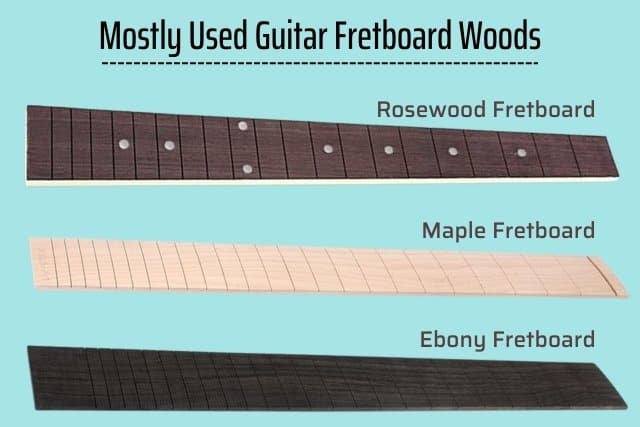
Here’s a quick and easy comparison summary you can reference when looking to distinguish between fretboard types:
Tone:
- Rosewood produces a warm, rich sound that is not at all harsh
- Maple produces a bright sound with snappy high-end
- Ebony produces a bright tone with good sustain
Color:
- Rosewood is a deep-brown, coffee color tinged with red
- Maple is a distinctly light, cream-colored wood
- Ebony wood is black; jet black in most cases
Finish:
- No finish is required for a rosewood board, though some are very lightly coated with a protectant
- Maple requires a protective finish that may be matte, satin, gloss, lacquer, or oil
- A naturally oily wood, ebony requires no finish
Feel/Playability
- Rosewood boards have a slick, fast playability
- The playability of a maple fretboard depends on the type of finish used. May be “sticky”
- Like rosewood, ebony fingerboards are fast and slick
Durability
- Rosewood fretboards are generally hard-wearing
- Also hard-wearing, maple boards are more apt to stain
- Ebony fingerboards are extremely hard-wearing, compared to rosewood or maple
Maintenance
- Rosewood requires occasional treatment
- Maple does not require conditioning
- Also, Ebony does not require conditioning
Weight
- Rosewood is generally heavier
- Maple is lighter
- In terms of weight, ebony is similar to rosewood
Price Range
- Rosewood’s price is on the Mid-range level
- Maple is on the lower end
- Compared to the other two, ebony is on the higher-end
Historical Significance
- Rosewood has been widely used, iconic
- Maple has been used in many Fender guitars, classic look
- Ebony has been used in high-end guitars, classic look
In 2023, some researchers analyzed 874 models from the top 14 global acoustic guitar manufacturers, compiling a study on the use and sustainability of wood in acoustic guitars. Based on their findings, the following table details the usage and concerns for ebony, rosewood, and maple in different guitar components.
| Wood Type | Usage in Guitars | Sustainability Concerns |
| Ebony (Diospyros spp.) | – 60.07% of guitar bridges – 57.08% of fingerboards – 51.26% of headplates | – All Dalbergia species are CITES Appendix II, except Brazilian rosewood (Appendix I) – Several species are Endangered or Critically Endangered on the IUCN Red List – Brazilian rosewood decline led to CITES listing |
| Rosewood (Dalbergia spp.) | – 26.81% of guitar back and sides | – Genus is considered high priority for conservation by GTTN – Some individual maple species are listed as Vulnerable on the IUCN Red List – Used as a more sustainable alternative to rosewoods |
| Maple (Acer spp.) | – 2.60% overall usage – 6.69% of fingerboards | – Genus is considered high priority for conservation by GTTN – Some individual maple species are listed as Vulnerable on IUCN Red List – Used as a more sustainable alternative to rosewoods |
Here’s an explainer video on the same topic from Crimson Custom Guitars. Check it out:

Frequently Asked Questions
What is the best guitar fretboard wood?
The best fretboard wood is very much a matter of personal preference. Personally, my favorite guitar to play has a maple board, but I know guitarists who aren’t fond of them at all. When it comes to fretboard woods, the only way to know which is best for you is to try and play them all before you decide.
Can you use any wood for a fretboard?
Yes, you can use any wood for a guitar fretboard, but it should meet certain requirements. The wood should be hard enough to withstand the scratching friction of a guitar’s strings and durable enough to not wear down quickly. It should also have a fine enough grain to present a smooth surface.
Traditional fretboard woods include African ebony, maple, and rosewood, but other woods like walnut, oak, and even synthetic materials like carbon-fiber composites can be used
Are ebony fingerboards more expensive?
Yes, ebony fingerboards are generally more expensive due to their high density and rarity compared to other woods commonly used for fretboards, such as rosewood.
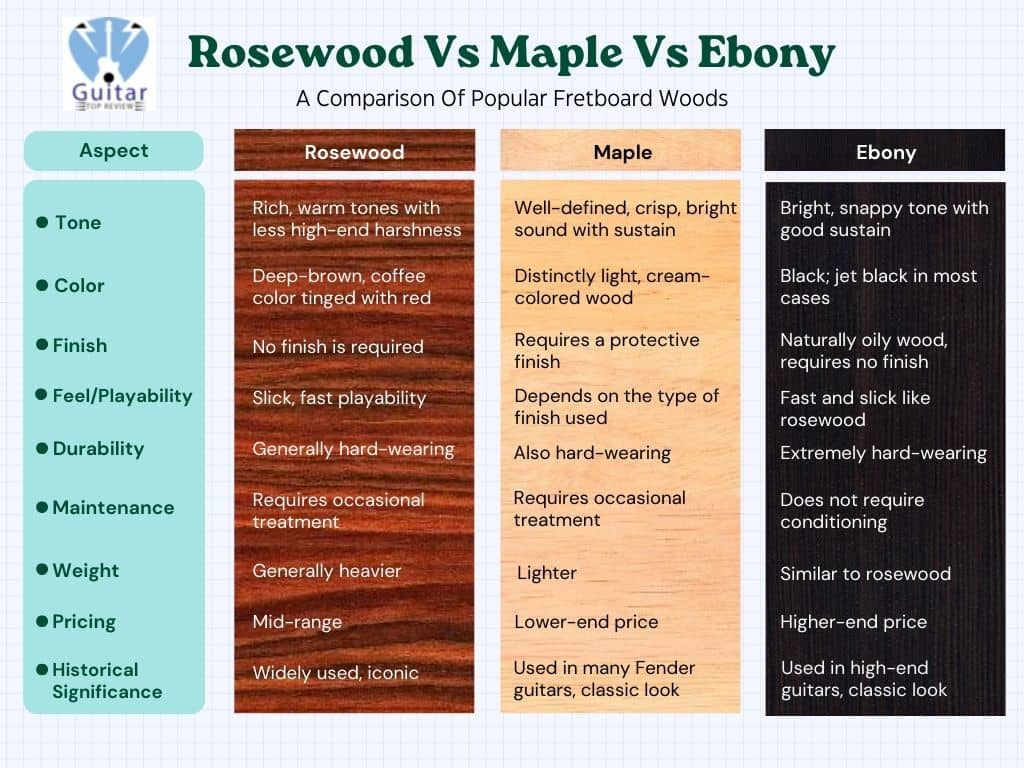
About the Author
Thomas M., the founder of Guitar Top Review, boasts 15+ years of guitar experience and was a church band member in L.A. Transitioning from piano to acoustic guitar, his first love remains his Taylor GS Mini. Alongside like-minded hobbyist friends, he launched the site, driven by a deep love for music that transcends professional boundaries.

